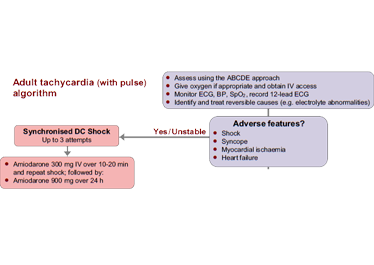
Initial observations
Select each number to find out more. Click on the Algorithm tab to see a larger version of the image.


The ABCDE approach stands for:
- Airway
- Breathing
- Circulation
- Disability
- Exposure
It should be the first step in the assessment of all deteriorating or critically ill patients. You can find more detail on the ABCDE approach in chapter 3 of the ALS manual.
Select each number to find out more. Click on the Algorithm tab to see a larger version of the image. Select Next to continue.

Adverse features imply that a patient’s condition is unstable and at risk of deterioration. The following adverse features indicate that a patient is at risk of deterioration either wholly or partly because of their arrhythmia:
- Shock – features include: hypotension (systolic blood pressure <90 mmHg), pallor, sweating, cold extremities, confusion and impaired consciousness
- Syncope –transient loss of consciousness because of global reduction in blood flow to the brain
- Heart failure – features include: pulmonary oedema and/or raised jugular venous pressure (with or without peripheral oedema and liver enlargement)
- Myocardial ischaemia –features include: typical ischaemic chest pain and/or evidence of myocardial ischaemia on a 12-lead ECG
Select each number to find out more. Click on the Algorithm tab to see a larger version of the image. Select Next to continue.

In addition to these adverse features it may be appropriate to consider extremes of heart rate as an adverse feature in itself. Patients who present with an extreme tachycardia may require more urgent assessment and treatment than those with less extreme tachycardia and no adverse features.
Select each number to find out more. Click on the Algorithm tab to see a larger version of the image. Select Next to continue.References
See chapter 11 of the ALS manual for further reading about the principles of treatment for tachycardia.







